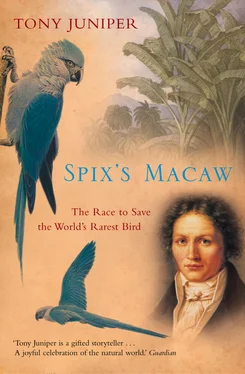It seems that the last living Glaucous Macaw reliably identified by a scientist was the one kept in the Paris Zoo (Jardin d’Acclimatation) for ten years from 1895. Whatever the reasons for its rapid slide into oblivion, the Glaucous Macaw – a large and conspicuous blue parrot – had become extinct and no one had noticed until decades after the event. Indeed, one leading parrot expert blithely described the species as ‘rare’ even in the late 1970s, by when it had not been seen for certain in the wild for more than a century. Certainly no one in the Berlin Zoo in 1900 would have realised that they were gazing upon a doomed species.
In the 1970s, ornithologists believed that a similar fate awaited the gorgeous blue Lear’s Macaw ( Anodorhynchus leari ). This parrot was known to Victorian naturalists as a similar-sized species to the Glaucous Macaw (although a little larger at 71 centimetres) and the two were obviously close evolutionary relatives. The Lear’s was, however, darker, deeper blue and more glossy; in some respects it was more like the Hyacinth Macaw, from which it was distinguished not only by size but by a curious facial expression created by the oval bare yellow skin patches around the eyes that made the birds look a bit sleepy.
The English name ‘Lear’s Macaw’ came from the title conferred on the species by French biologist Prince Charles Bonaparte – the nephew of Napoleon – who in 1856 wrote the first scientific description of the species. The Englishman Edward Lear, much better known for his nonsense verse, had illustrated the macaw in his book Illustrations of the Family of Psittacidae, or Parrots . The first instalment of this work appeared in 1830. Lear was then a promising young artist who had begun work on painting parrots at a time when their popularity was soaring. Despite the care Lear devoted to his work, in common with others he mistakenly believed that his painting of the blue macaw was of a Hyacinth. Although he had the ‘wrong’ species, he did produce an excellent painting and the name stuck and remains with us today, alongside the bird’s other common English name: Indigo Macaw.
But during the nineteenth century, Lear’s Macaw was even less well documented than its enigmatic cousin the Glaucous. A very few specimens were added to museum collections following the death of birds in zoos, but their natural origin was quite obscure. Although odd ones turned up in the USA and Europe in consignments of Hyacinth Macaws from Brazil, they were also rare in captivity. Scarcity and mystery added to their collectability; the rarity and obscurity made demand for them greater, not less.
Конец ознакомительного фрагмента.
Текст предоставлен ООО «ЛитРес».
Прочитайте эту книгу целиком, купив полную легальную версию на ЛитРес.
Безопасно оплатить книгу можно банковской картой Visa, MasterCard, Maestro, со счета мобильного телефона, с платежного терминала, в салоне МТС или Связной, через PayPal, WebMoney, Яндекс.Деньги, QIWI Кошелек, бонусными картами или другим удобным Вам способом.












